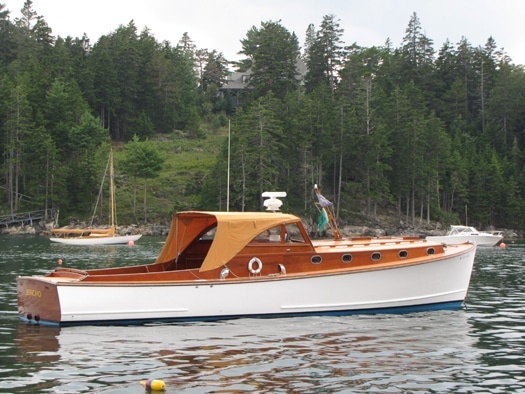
ytgnov25enewsvarn525.jpg
When is it time to revarnish your exterior brightwork? I used to apply at least three coats on the trim of my 1962 Pacemaker every spring. In addition, I would make sure two coats were applied in the fall to protect the finish from the long winter ahead. Applying one coat of varnish, especially after the prep and the taping involved, is a waste of time. Make sure you apply at least two coats.
Pay close attention to any deterioration around seams and edges, or where water has been able to intrude. Do not let these spread. I had an issue around my stanchion bases, until I removed these and rebedded the bases, fighting off the moisture. If you see light areas or dead varnish, you’ll need to repair and build these back up before finish coats are applied to the entire surface.
To make this repair, the first thing you want to do is to remove the old varnish. I continue to swear by the Red Devil 1-inch scrapers. I’ve had several for decades and they work well for small tasks like seam repair. Just make sure you keep the blade sharp. Also, be careful not to mark the wood or dig too deep with the scraper.
While repairing seams or small blemishes, try to keep the area you are working with small. The object is to fair in the damaged spot with the good varnish. By keeping this area relatively small, the fairing job is much easier.
A common mistake made with this process is not having the patience to fair bare wood after you remove the old varnish. Believe me I’ve kicked myself on more than one occasion for not taking the proper steps. You want to start with 120 grit paper, then go up to a 150-sheet, and end with a 220-grit once the wood is smooth. If this is not done properly, you can be left with scratches from the scraper and sanding.
The mahogany transom on my Pacemaker would often lift at the scarf joints. In a few areas, water would penetrate and darken the joints. If your wood has a few of these dark spots, do yourself a favor, and take the time to bleach these out with a teak care product and soft pad. Make sure the area is completely dry before you varnish, or the entire process will be for naught.
After the spot is stripped, you may need to stain the area in order to blend it with the rest of the brightwork. This is more common, in my opinion, with mahogany finishes. With teak, I’ve seen people go nuts trying to “match” the finish to a uniformed look. My friend Bruce Livingston, who built Little Harbor custom sailboats, and worked with me at Grand Banks, and is now at Vicem (and they know wood) used to say the object is to “blend.” I agree. But if you’re set on staining, go with a product from the same company as your varnish.
And make doubly sure that you stir until your hand falls off. I’ve ruined my work by applying a stain, but all the pigment was stuck at the bottom of the can. So all I did was smear colorless oil. Great move, Sass.
Then it’s time to start laying some varnish on the prepped spots. What type of brush? To build coats, I go with foam brushes at this point. I can toss them after each application and save my finish brushes for the larger applications.
When applying varnish to bare wood, make sure you thin the first coat. I thin the first coat by 50 percent. Since this dries in a few hours, you can go back on the same day with a second coat, thinned by 25 percent. Do not sand after these coats.
Then, you can build the spots back with varnish and minimal thinner. Apply one coat a day and sand with a 220 grit paper, until the areas are built up to the same thickness as the surrounding varnish. Then it’s time to varnish the entire area to get the golden finish.









